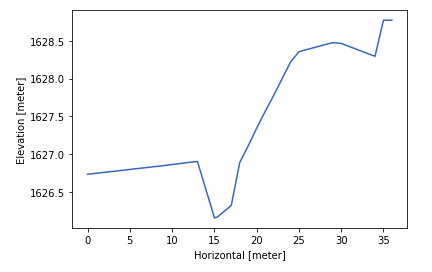Read, write and manipulate dfs0, dfs1, dfs2, dfs3, dfsu and mesh files. Read res1d and xns11 files.
Facilitates common data processing workflows for MIKE files.
- Windows operating system
- Python x64 3.6, 3.7 or 3.8
- VC++ redistributables (already installed if you have MIKE)
The latest version of mikeio (v 0.5), has a lot of new functionality, but also several breaking changes to the API !! It was released on 2020-09-03.
From PyPI:
pip install mikeio
Or development version:
pip install https://github.com/DHI/mikeio/archive/master.zip
Generic read method to read values, if you need additional features such as coordinates, use specialised classes instead e.g. Dfsu
>>> import mikeio
>>> ds = mikeio.read("random.dfs0")
>>> ds
<mikeio.DataSet>
Dimensions: (1000,)
Time: 2017-01-01 00:00:00 - 2017-07-28 03:00:00
Items:
0: VarFun01 <Water Level> (meter)
1: NotFun <Water Level> (meter)
>>> ds = mikeio.read("random.dfs1")
>>> ds
<mikeio.DataSet>
Dimensions: (100, 3)
Time: 2012-01-01 00:00:00 - 2012-01-01 00:19:48
Items:
0: testing water level <Water Level> (meter)>>> from mikeio import Dfs0
>>> dfs = Dfs0('simple.dfs0')
>>> ts = dfs.to_dataframe()>>> from datetime import datetime
>>> import numpy as np
>>> from mikeio import Dfs0
>>> data = [np.random.random([100])]
>>> dfs = Dfs0()
>>> dfs.write('simple.dfs0', data, start_time=datetime(2017, 1, 1), dt=60)import pandas as pd
import mikeio
>>> df = pd.read_csv(
... "tests/testdata/co2-mm-mlo.csv",
... parse_dates=True,
... index_col="Date",
... na_values=-99.99,
... )
>>> df.to_dfs0("mauna_loa.dfs0")For more examples on timeseries data see this notebook
>>> from mikeio import Dfs2
>>> dfs = Dfs2("random.dfs2")
>>> ds = dfs.read()
>>> ds
<mikeio.DataSet>
Dimensions: (3, 100, 2)
Time: 2012-01-01 00:00:00 - 2012-01-01 00:00:24
Items:
0: testing water level <Water Level> (meter)For a complete example of conversion from netcdf to dfs2 see this notebook.
Another example of downloading meteorological forecast from the Global Forecasting System and converting it to a dfs2 ready to be used by a MIKE 21 model.
>>> from mikeio import res1d
>>> # Query the discharge time series at chainage 10.1 of branch1
>>> q1 = res1d.QueryData('Discharge', 'branch1', 10.1)
>>> # Query all the discharge time series of branch2
>>> q2 = res1d.QueryData('Discharge', 'branch2')
>>> # Query all the water level time series in the file
>>> q3 = res1d.QueryData('WaterLevel')
>>> # Combine the queries in a list
>>> queries = [q1, q2, q3]
>>> # The returned ts object is a pandas DataFrame
>>> ts = res1d.read('res1dfile.res1d', queries)For more examples on Res1D see this notebook
>>> import matplotlib.pyplot as plt
>>> from mikeio import xns11
>>> # Query the geometry of chainage 58.68 of topoid1 at reach1
>>> q1 = xns11.QueryData('topoid1', 'reach1', 58.68)
>>> # Query the geometry of all chainages of topoid1 at reach2
>>> q2 = xns11.QueryData('topoid1', 'reach2')
>>> # Query the geometry of all chainages of topoid2
>>> q3 = xns11.QueryData('topoid2')
>>> # Combine the queries in a list
>>> queries = [q1, q2, q3]
>>> # The returned geometry object is a pandas DataFrame
>>> geometry = xns11.read('xsections.xns11', queries)
>>> # Plot geometry of chainage 58.68 of topoid1 at reach1
>>> plt.plot(geometry['x topoid1 reach1 58.68'],geometry['z topoid1 reach1 58.68'])
>>> plt.xlabel('Horizontal [meter]')
>>> plt.ylabel('Elevation [meter]')>>> import matplotlib.pyplot as plt
>>> from mikeio import Dfsu
>>> dfs = Dfsu("HD.dfsu")
>>> ds = dfs.read()
>>> idx = dfs.find_nearest_element(x=608000, y=6907000)
>>> plt.plot(ds.time, ds.data[0][:,idx])For more examples on working with dfsu see these notebooks:
Useful when creating a new dfs file
>>> from mikeio.eum import EUMType, EUMUnit
>>> EUMType.Temperature
<EUMType.Temperature: 100006>
>>> EUMType.Temperature.units
[degree Celsius, degree Fahrenheit, degree Kelvin]
>>> EUMUnit.degree_Kelvin
degree KelvinMIKE IO is tested extensively. 93% total test coverage.
See detailed test coverage report below:
----------- coverage: platform win32, python 3.7.4-final-0 -----------
Name Stmts Miss Cover
--------------------------------------------
mikeio\__init__.py 33 1 97%
mikeio\aggregator.py 104 9 91%
mikeio\dfs.py 75 5 93%
mikeio\dfs0.py 186 34 82%
mikeio\dfs1.py 75 5 93%
mikeio\dfs2.py 118 10 92%
mikeio\dfs3.py 160 78 51%
mikeio\dfs_util.py 40 14 65%
mikeio\dfsu.py 815 55 93%
mikeio\dotnet.py 63 4 94%
mikeio\dutil.py 117 7 94%
mikeio\eum.py 1196 2 99%
mikeio\generic.py 126 1 99%
mikeio\helpers.py 6 0 100%
mikeio\res1d.py 202 7 97%
mikeio\spatial.py 31 11 65%
mikeio\xns11.py 199 6 97%
--------------------------------------------
TOTAL 3546 249 93%
========================================== 199 passed ==================



